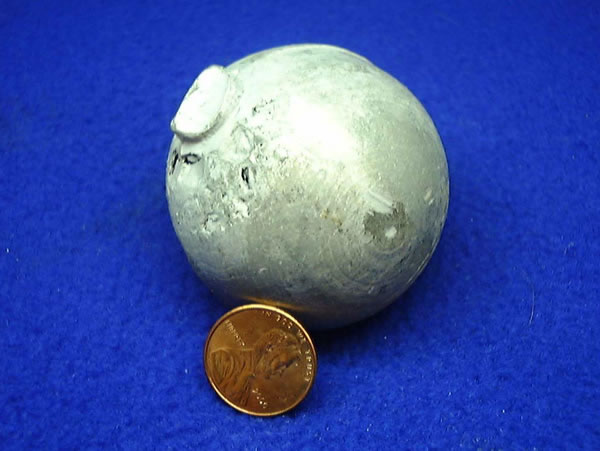Cadmium
Template:Elementbox header Template:Elementbox series Template:Elementbox groupperiodblock Template:Elementbox appearance img Template:Elementbox atomicmass gpm Template:Elementbox econfig Template:Elementbox epershell Template:Elementbox section physicalprop Template:Elementbox phase Template:Elementbox density gpcm3nrt Template:Elementbox densityliq gpcm3mp Template:Elementbox meltingpoint Template:Elementbox boilingpoint Template:Elementbox heatfusion kjpmol Template:Elementbox heatvaporiz kjpmol Template:Elementbox heatcapacity jpmolkat25 Template:Elementbox vaporpressure katpa Template:Elementbox section atomicprop Template:Elementbox crystalstruct Template:Elementbox oxistates Template:Elementbox electroneg pauling Template:Elementbox ionizationenergies3 Template:Elementbox atomicradius pm Template:Elementbox atomicradiuscalc pm Template:Elementbox covalentradius pm Template:Elementbox vanderwaalsrad pm Template:Elementbox section miscellaneous Template:Elementbox magnetic Template:Elementbox eresist ohmm Template:Elementbox thermalcond wpmkat300k Template:Elementbox thermalexpansion umpmkat25 Template:Elementbox speedofsound rodmpsat20 Template:Elementbox youngsmodulus gpa Template:Elementbox shearmodulus gpa Template:Elementbox bulkmodulus gpa Template:Elementbox poissonratio Template:Elementbox mohshardness Template:Elementbox brinellhardness mpa Template:Elementbox cas number |- ! colspan="2" style="background:#ffc0c0; color:black" | Selected isotopes |- | colspan="2" |
| iso | NA | half-life | DM | DE (MeV) | DP
Template:Elementbox isotopes decay Template:Elementbox isotopes decay Template:Elementbox isotopes decay Template:Elementbox isotopes decay Template:Elementbox isotopes stable Template:Elementbox isotopes stable Template:Elementbox isotopes stable Template:Elementbox isotopes decay Template:Elementbox isotopes decay2 Template:Elementbox isotopes decay Template:Elementbox isotopes decay Template:Elementbox isotopes decay Template:Elementbox isotopes end Template:Elementbox footer Editor-In-Chief: C. Michael Gibson, M.S., M.D. [3]
OverviewCadmium (Template:PronEng) is a chemical element with the symbol Cd and atomic number 48. A relatively rare, soft, bluish-white, transition metal, cadmium is known to cause cancer and occurs with zinc ores. Cadmium is used largely in batteries and pigments, for example in plastic products. Notable characteristicsCadmium is a soft, malleable, ductile, toxic, bluish-white bivalent metal. It is similar in many respects to zinc but reacts to form more complex compounds. The most common oxidation state of cadmium is +2, though rare examples of +1 can be found. ApplicationsUses of cadmium include:
HistoryCadmium (Latin cadmia, Greek καδμεία meaning "calamine", a Cadmium-bearing mixture of minerals, which was named after the Greek mythological character, Κάδμος (Cadmus)) was discovered in Germany in 1817 by Friedrich Strohmeyer. Strohmeyer found the new element within an impurity in zinc carbonate (calamine) and for 100 years Germany remained the only important producer of the metal. The metal was named after the Latin word for calamine since the metal was found in this zinc compound. Strohmeyer noted that some impure samples of calamine changed color when heated but pure calamine did not. Even though cadmium and its compounds are highly toxic, the British Pharmaceutical Codex from 1907 states that cadmium iodide was used as a medicine to treat "enlarged joints, scrofulous glands, and chilblains". Toxicity Cadmium is an occupational hazard associated with industrial processes such as metal plating and the production of nickel-cadmium batteries, pigments, plastics and other synthetics. The primary route of exposure in industrial settings is inhalation. Inhalation of cadmium-containing fumes can result initially in metal fume fever but may progress to chemical pneumonitis, pulmonary edema, and death.[1] Cadmium is also a potential environmental hazard. Human exposures to environmental cadmium are primarily the result of the burning of fossil fuels and municipal wastes.[2] However, there have been notable instances of toxicity as the result of long-term exposure to cadmium in contaminated food and water. In the decades following World War II, Japanese mining operations contaminated the Jinzu River with cadmium and traces of other toxic metals. Consequently, cadmium accumulated in the rice crops growing along the riverbanks downstream of the mines. The local agricultural communities consuming the contaminated rice developed Itai-itai disease and renal abnormalities, including proteinuria and glucosuria.[3] Cadmium is one of six substances banned by the European Union's Restriction on Hazardous Substances (RoHS) directive, which bans carcinogens in computers. Cadmium and several cadmium-containing compounds are known carcinogens and can induce many types of cancer.[4] Current research has found that cadmium toxicity may be carried into the body by zinc binding proteins; in particular, proteins that contain zinc finger protein structures. Zinc and cadmium are in the same group on the periodic table, contain the same common oxidation state (+2), and when ionized are almost the same size. Due to these similarities, cadmium can replace zinc in many biological systems, in particular, systems that contain softer ligands such as sulfur. Cadmium can bind up to ten times more strongly than zinc in certain biological systems, and is notoriously difficult to remove. In addition, cadmium can replace magnesium and calcium in certain biological systems, although these replacements are rare. Tobacco smoking is the most important single source of cadmium exposure in the general population. It has been estimated that about 10% of the cadmium content of a cigarette is inhaled through smoking. The absorption of cadmium from the lungs is much more effective than that from the gut, and as much as 50% of the cadmium inhaled via cigarette smoke may be absorbed. On average, smokers have 4-5 times higher blood cadmium concentrations and 2-3 times higher kidney cadmium concentrations than non-smokers. Despite the high cadmium content in cigarette smoke, there seems to be little exposure to cadmium from passive smoking. No significant effect on blood cadmium concentrations could be detected in children exposed to environmental tobacco smoke. PrecautionsWhile working with cadmium it is important to do so under a fume hood or with the use of an appropriate respirator to protect against dangerous fumes.[5] Solder, for example, which may contain cadmium, should be handled with care.
References
External links
af:Kadmium ar:كادميوم bn:ক্যাডমিয়াম be:Кадмій bs:Kadmijum ca:Cadmi cs:Kadmium co:Cadmiu da:Cadmium de:Cadmium et:Kaadmium el:Κάδμιο eo:Kadmio eu:Kadmio fa:کادمیوم fur:Cadmi ga:Caidmiam gl:Cadmio (elemento) ko:카드뮴 hy:Կադմիում hi:काडमियम hr:Kadmij io:Kadmio id:Kadmium is:Kadmín it:Cadmio he:קדמיום sw:Cadimi ht:Kadmyòm ku:Kadmiyûm la:Cadmium lv:Kadmijs lb:Cadmium lt:Kadmis jbo:jinmrkadmu hu:Kadmium nl:Cadmium no:Kadmium nn:Kadmium oc:Cadmi uz:Kadmiy nds:Cadmium qu:Kadmiyu sq:Kadmiumi scn:Cadmiu simple:Cadmium sk:Kadmium sl:Kadmij sr:Кадмијум sh:Kadmijum fi:Kadmium sv:Kadmium ta:காட்மியம் th:แคดเมียม uk:Кадмій |
|---|